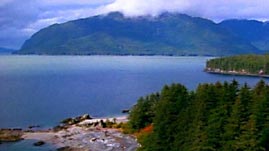Teachers' Domain - Digital Media for the Classroom and Professional Development
User: Preview

Source:
New Bedford Whaling Museum
Peabody Essex Museum
This video, adapted from material provided by the ECHO partners, offers a glimpse of life in three coastal communities in the United States. The visit begins in Alaska on the Kenai Peninsula, specifically in the village of Nanwalek, where people have learned to survive in a harsh environment. Next we travel to New Bedford, Massachusetts, to see how people have always depended on the ocean for whaling and fishing. Finally we go to Moloka‘i in Hawai‘i, where people have learned to respect the ocean for what it provides its island communities.
The coast—where ocean water meets land—is a dynamic environment teeming with life. Coastal oceans, which stretch from inland rivers and bays to the edge of the continental shelf where the deep ocean begins, account for about 10 percent of the ocean's surface area. Yet because sunlight and nutrients are more accessible in shallow waters than in the deep ocean, coastal regions contain about half of the ocean's microscopic plants. These plants are eaten by zooplankton (microscopic animals), which in turn are eaten by larger animals, including fish and marine mammals. This coastal food web ultimately feeds humans, providing most of the world's fish catch.
There are many different kinds of coastal "ecosystems," the particular environment and organisms that live and interact there. Hawai‘i, for example, is home to a diverse collection of marine ecosystems that survive well in a tropical climate. These include coral reefs, rocky coasts, sandy coasts, and marine pools. Hawai‘i's geographic isolation—it is about 2,500 miles from the nearest continent—means that many of these ecosystems are dominated by "endemic" (native) species that can be found nowhere else.
The New England coastline is home to ecosystems that thrive in a temperate climate of cold winters, warm summers, and strong winds. Much of the coastline is rocky, with some sandy beaches. Many plants and animals in the New England ecosystems depend on the nutrients and flow patterns unique to "estuaries," which are areas where freshwater rivers and seawater meet. The region is known for its shellfish populations, but is also home to a variety of fish, mammals, reptiles, birds, and plants that thrive in the estuary ecosystem.
The Alaska region includes half of the U.S. coastline. This coastline contains many different ecosystems—ranging from fjords and ice fields to estuaries and rocky coasts. These ecosystems provide homes for a variety of marine species, including fish, such as salmon, and some of the world's largest populations of marine mammals and sea birds. The Alaskan coast shown in this video is in Southcentral Alaska, a region where much of the coastal water remains ice-free except during extreme cold snaps.
Although ecosystems are constantly changing because of natural events, humans pose an ever-growing threat to coastal environments. About half of Earth's population lives within 50 miles of a coast, and even more depend on resources that come from the ocean (such as fish and oil) or that are transported by ship through its harbors. Coastal areas are also very popular for tourism and recreation.
Activities far inland can affect coastal ecosystems. For example, pesticides and other pollutants carried by streams from as far away as the Midwest can increase the growth of algae in coastal waters. Increased populations of algae can interfere with the growth of other marine plants, which ultimately affect the survival of fish and shellfish. As more people live near, visit, or depend on the resources offered by the world's coastlines, it becomes increasingly important that everyone help to maintain the health and productivity of these valuable coastal ecosystems.
 Loading Standards
Loading Standards Education through Cultural and Historical Organizations (ECHO) offers you resources on Teachers' Domain that strengthen knowledge of local culture and identity.
Education through Cultural and Historical Organizations (ECHO) offers you resources on Teachers' Domain that strengthen knowledge of local culture and identity.
